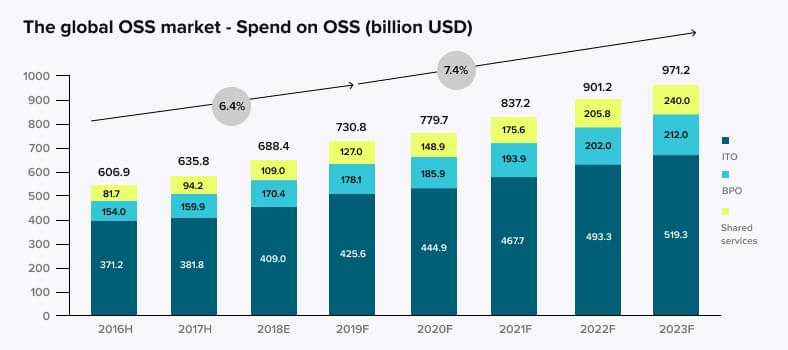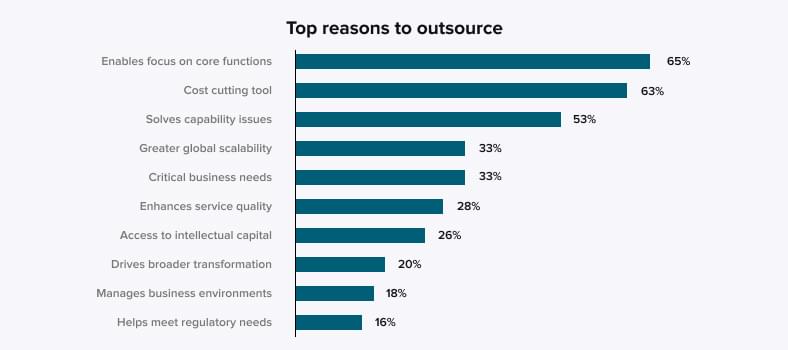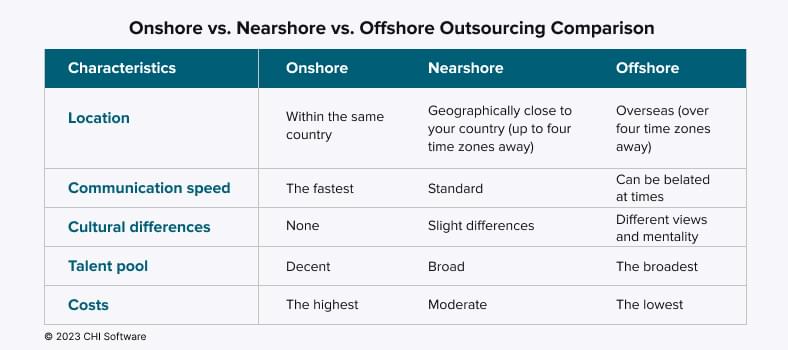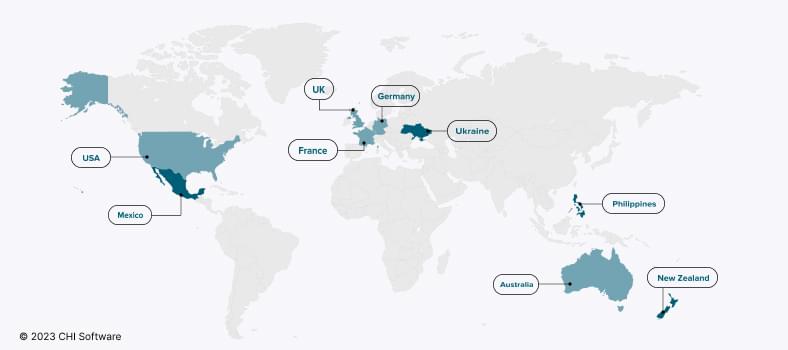Finding the right talent has never been easy. Working in IT, you have access to thousands of experts located across the globe, but the task remains challenging. Nearshore software development services may be an ideal option to cover your needs.
Onshore, nearshore, and offshore outsourcing have been known to business owners for quite a while, and their popularity is likely to intensify after the lockdown waves. So if not now, when?
Here is your guide to nearshore development, including a short comparison with onshore and offshore models.
A Few Words About the Trends in Outsourcing Software Development
OSS (Outsourcing and Shared Services) is a well-developed industry that started forming in the 1980s. At first, it was intended to raise cost-effectiveness but gained much more advantages with time.
Looking at the industry now, one can notice how fast OSS helps businesses adopt innovations and remain competitive. Outsourcing provides the required level of expertise in just a couple of weeks, which is quite problematic (if not impossible) for traditional hiring.
Now, let us check the stats.
According to Deloitte, the global OSS market has been growing steadily over the years from 606.9 billion USD in 2016 to 901.2 billion USD in 2022. ITO (IT Outsourcing) has been the industry’s driver, taking up more than half of the market’s volume.

Another survey shows that businesses outsource certain IT services more often than others. The top three include cybersecurity, software development, and IT infrastructure services.

The primary cause for outsourcing, regardless of the market, is the ability to focus on core business needs and functions (cost reduction is in second place).

While the world is changing faster each year, companies need an efficient tool to adapt and manage their hiring process. Outsourcing has proven to be the sweet spot to meet business concerns. But where on Earth should you look for the perfect contractor? There are some aspects to consider before answering this question.
What Are the Types of Software Development Outsourcing?
Outsourcing is divided into three types based on the vendor’s geographical location: onshore, nearshore, and offshore. Each type has its pros and cons, and picking one or another heavily depends on the company’s budget, goals, and risk preparedness.

Onshore software development implies hiring specialists in the same country. For some countries, especially developed ones, this option is the most expensive of the three.
Example: a UK company hires a UK vendor.
This option is for you if:
- Your project requires frequent in-person communication;
- There are data privacy restrictions regarding the specialist’s location;
- Your project involves complex IoT hardware development and tight collaboration between hardware and software teams.
Offshore software development involves hiring a team from a distant country (across the ocean). Causing some workflow challenges, this option is still highly attractive for companies interested in cost saving.
How to approach IT staffind in 2023?
Read on
When hiring “far from home”, you should keep in mind cultural and time zone differences, along with language barriers. Any of these factors may cause development protractions and deadline violations.
Example: a US company hires a European, Indian, or Chinese vendor.
This option is for you if:
- You need a contractor for repetitive tasks that do not require frequent updates;
- You are looking for IT support services;
- The differences in working hours fit your usual schedule;
- You consider the optimal price-performance ratio, which sometimes may be found only overseas.
Nearshore software development means employing a team located in a neighboring country or on the same continent, within the same (or close) time zone. As a rule, a company from a developed country would hire engineers located in a developing country with lower rates.
This option became more popular during the pandemic while the world was adapting to remote working processes. Even companies following a more traditional workflow are now more open to online cooperation.
Example: a UK company hires a European vendor, or a US company hires a South American vendor.
This option is for you if:
- Your project requires frequent communication but not necessarily offline;
- You aim to develop a new software solution from scratch with a lot of brainstorming and strategic sessions needed in real time;
- Cultural similarities play a big role for your team and corporate policy.
As it might be seen, nearshore development is a happy medium for those looking for a less costly yet convenient workflow. Here are more reasons to consider this outsourcing model for your project.
What Are the Pros & Cons of Nearshore Custom Software Development?
Let us consider the advantages first. We have mentioned some of them in the general description, and now we will review them in more detail.

Pros
1. Similar working schedules
Thanks to close geographical proximity, you and your contractors start working at around the same time. How exactly is it beneficial? Software development teams are ready for real-time collaboration with no time lags. Keep in mind that several hours can sometimes save your product’s reputation.
Face-to-face communication is relatively easy because of more transportation options available. Plus, you save a lot of time: getting to a European country from the UK is several times faster than, for example, traveling to India.
2. A wider pool of talents
In some countries, software development services are a powerful tool, nurturing national exports. As a result, more people are focused on acquiring or upgrading their skills in the IT industry and more companies can offer their solid expertise.
Considering the circumstances, a lot of businesses do not mind increasing the distance to a contractor in order to find the right fit for their development project.
3. Similar cultural values
This point does not seem important until you face workflow issues because of trivial misunderstandings. The factor of culture can often get overlooked, as project management is concentrated more on budget and documentation. Meanwhile, different views and mentalities can cause conflicts and, subsequently, create more project risks.
How to estimate software development cost in 2023?
Read on
Experienced managers would say that dealing with cultural differences is a skill requiring much of their attention and even additional training (like studying negotiation styles typical for other countries). So, similar mentalities reduce the workload and allow teams to focus more of their attention on product quality.
4. Cost reduction
Outsourcing screams cost reduction because you do not have to rent a bigger office for a new team or equip employees with the necessary hardware. It is the contractor’s responsibility. Plus, a lot of IT outsourcing companies are located in developing countries with lower development rates. How tempting does it sound?
Cost-effectiveness must be one of the strongest motivations for businesses worldwide to opt for outsourcing nearshore or offshore. Nearshore in this case allows you to save some budget with minimum impact on working processes.
Even though the benefits look great, there are also reasons not to choose nearshore software development companies.
Cons
1. Not the cheapest option
When you choose a nearshore vendor, there is a great chance its rates are higher than those at a similar offshore company. Think of your goals and the price you are ready to pay for the advantages provided by nearshoring. If time zones and cultural differences are not a big deal for your project, then offshoring could be a better option.
2. More effort is needed for timely syncing
No matter what outsourcing model you pick, timely communication is one of the challenges to handle. Your team always works remotely, but you still need daily updates on the development process.
Hiring developers in London: in-house or nearshoring?
Read more
We at CHI Software set up a communication policy with clients right away: the schedule of the daily and weekly meetings, one messenger for urgent updates, task tracking software, the list of state holidays, etc. These measures make the working process as transparent as possible.
3. Not suitable for 24/7 support
This point is important for B2C products providing client support around the clock. If you expect a development team to be available at 2 am to solve urgent issues, nearshoring is not the best choice. Some companies do provide night shifts, but the number of such businesses is significantly lower than the number of available offshore contractors.
What Affects Nearshore Development Costs?

Software development nearshoring generally implies lower development rates. But when you look closer, you will notice cost variations. Here is why it happens.
Technologies
Some tech stacks are more widely used than others, but it does not mean they provide the desired quality level. Solid-quality engineering is about non-stop studying and exploring, pioneering innovations, and generating bold ideas. No wonder unique skills and efficient problem-solving come at a higher price on any market.
Project complexity
Updating an existing infrastructure or building a one-of-a-kind solution from scratch? These tasks are obviously of different complexity. The more innovative software you have in mind, the more time a team will spend on research, coming up with a feature set, and building an architecture.
CHI Software offers developing an MVP (Minimum Viable Product) first to make a general idea real and save a client from potential risks, including extra expenses.
Experts involved and project duration
Each project is unique and requires different experts involved. Maybe, you need a designer and a couple of developers working on your project long-term. Or you may need a bigger team following strict deadlines. The combination of expertise and duration heavily impacts development costs.
The rates depend on the specialist’s seniority too. The expertise of junior and senior developers differs drastically and inevitably affects the project’s budgeting.
The company’s reputation
You can fully trust software development companies with a stable market reputation. But you should also prepare to pay more for the brand and the quality it provides. You may surely get decent service quality from a lesser-known provider, but first, decide if you are ready to take the risk.
Why Is Hiring Nearshore Software Developers in Ukraine Still a Great Idea?

Oleg Chernyak, Chief Business Development Officer at CHI Software, in the company’s office after the full-scale invasion started. Photo by Emile Ducke for The New York Times
We are not going to hide elephants in mouseholes and pretend as if nothing special has happened in Ukraine. Being one of the biggest European software development centers, the country is now fighting for its existence, and so is the IT industry.
Hiring Ukrainian developers may be risky. But it is beneficial nonetheless. These specialists are still showing the whole world the meaning behind the words “high quality” and “dedication”. And here is why.
Motivation
IT specialists are more motivated to deliver outstanding solutions than ever before. The “economic front” is another severe battlefield for Ukrainians, and they strive to do their work well.
Before the full-scale invasion, IT in Ukraine was a driving force of national exports, growing by at least 20% yearly since 2016.
Despite all the challenges caused by the war, the industry continues growing thanks largely to Ukrainian businesses adapting their work policies. Ukrainian developers can contribute to the victory by at least paying taxes regularly. And you can help them. Just opt for their outstanding service.
Adaptation
What we call “adapting their working policies” is a range of organized (and sometimes disorganized) efforts to make the work comfortable for every employee regardless of stressful events. Indeed, a lot of companies were preparing their working operations for the worst-case scenario, which eventually became real.
Now Ukrainian offices are equipped with generators, Starlink Internet, charging stations, and safe shelters. Even in case of a total blackout in the city, development centers continue operating.
Rapidly increasing number of IT specialists
The war has caused a rise of unemployment in Ukraine. Working from any location is now essential but impossible for many businesses due to missile attacks and Russian occupation. The IT industry appears to be one of the most stable and reliable options under such circumstances.
The Ukrainian government has initiated the “Start in IT” program, providing scholarships to 60,000 Ukrainians with different backgrounds to study IT-related professions:
“This program is not for students and not for IT professionals. This program is for people who have previous work experience but now, for example, have lost their job or are idle and want to learn new skills for a new career. The state provides such an opportunity. In recent years, IT professionals have become a real middle class in Ukraine, so we are interested in their number only increasing,” stressed the Prime Minister Denys Smyhal.
It means that the number of IT specialists in Ukraine is growing even faster than before the full-scale war.
Conclusion
The technology sector is definitely one of the most flexible. You can hire specialists in-house or outsource development efforts across the ocean. Such opportunities were not even imaginable several decades ago.
Picking onshore, nearshore, or offshore outsourcing is a matter of individual business needs and risks you are ready to face. There is no one-fit-all recipe for everyone. Are you looking for lower costs and convenient communication? Then you need to consider a nearshore development company.
The CHI Software team has been working with clients from Israel and Western European countries since 2015. We know how to set up efficient collaboration and provide top-notch quality. Web, mobile, or artificial intelligence – we have hundreds of experts on board to make innovations happen.
About the author
Polina is a curious writer who strongly believes in the power of quality content. She loves telling stories about trending innovations and making them understandable for the reader. Her favorite subjects include AI, AR, VR, IoT, design, and management.
Rate this article
24 ratings, average: 4.5 out of 5









